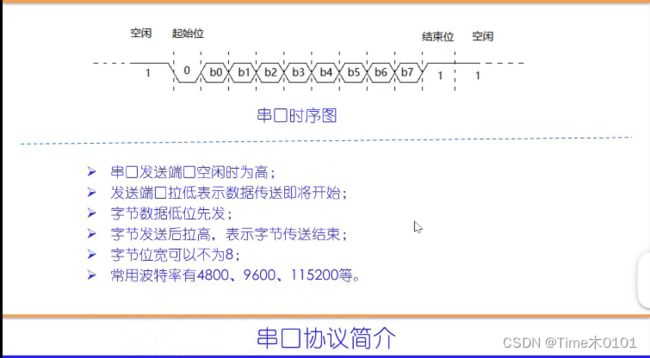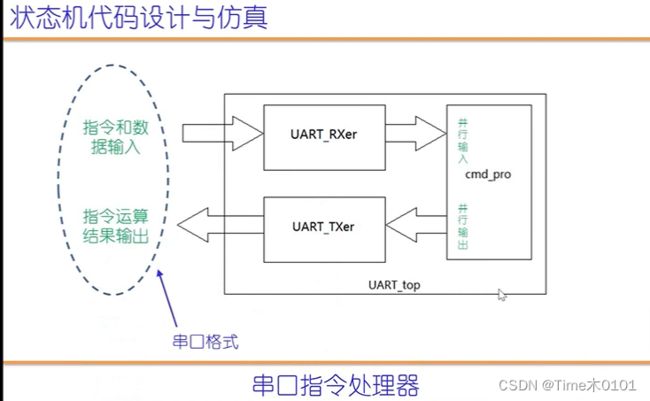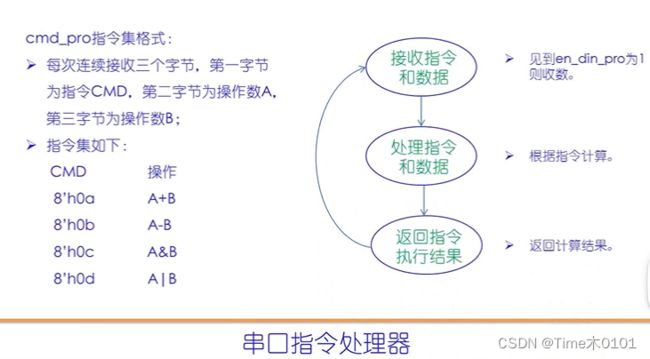Verilog零基础入门(边看边练与测试仿真)-状态机-笔记(7-10讲)
文章目录
- 第七讲
- 第八讲
- 第九讲
- 第十讲
第七讲
1、两种状态的代码:
//最简单的状态机,三角波发生器;
`timescale 1ns/10ps
module tri_gen(
clk,
res,
d_out
);
input clk;
input res;
output[8:0] d_out;
reg state;//主状态机寄存器
reg[8:0] d_out;
always@(posedge clk or negedge res )
if(~res)begin
state<=0;d_out<=0;
end
else begin
case(state)
0://上升;
begin
d_out<=d_out+1;
if(d_out==299)begin
state<=1;
end
end
1://下降
begin
d_out<=d_out-1;
if(d_out==1)begin
state<=0;
end
end
endcase
end
endmodule
//---------testbench of tri_gen-----
module tri_gen_tb;
reg clk,res;
wire[8:0] d_out;
tri_gen U1(
.clk(clk),
.res(res),
.d_out(d_out)
);
initial begin
clk<=0;res<=0;
#17 res<=1;
#8000 $stop;
end
always #5 clk<=~clk;
endmodule
//2023-0913,time
//最简单的状态机,三角波发生器;
`timescale 1ns/10ps
module tri_gen(
clk,
res,
d_out
);
input clk;
input res;
output[8:0] d_out;
reg[1:0] state;//主状态机寄存器
reg[8:0] d_out;
reg[7:0] con;//计数器,记录平顶周期个数
always@(posedge clk or negedge res )
if(~res)begin
state<=0;d_out<=0;con<=0;
end
else begin
case(state)
0://上升;
begin
d_out<=d_out+1;
if(d_out==299)begin
state<=1;
end
end
1://平顶
begin
if(con==200)begin
state<=2;
con<=0;
end
else begin
con<=con+1;
end
end
2://下降
begin
d_out<=d_out-1;
if(d_out==1)begin
state<=3;
end
end
3://平顶
begin
if(con==200)begin
state<=0;
con<=0;
end
else begin
con<=con+1;
end
end
endcase
end
endmodule
//---------testbench of tri_gen-----
module tri_gen_tb;
reg clk,res;
wire[8:0] d_out;
tri_gen U1(
.clk(clk),
.res(res),
.d_out(d_out)
);
initial begin
clk<=0;res<=0;
#17 res<=1;
#40000 $stop;
end
always #5 clk<=~clk;
endmodule
仿真波形:

3、如果state定义的[1:0],也就是有四种状态,那么如果有没用到的状态,应该用default写完全。
第八讲
//2023-09-18,time
//串口数据接收
`timescale 1ns/10ps
module UART_RXer(
clk,
res,
RX,
data_out,
en_data_out
);
input clk;
input res;
input RX;
output[7:0] data_out;//接受字节输出;
output en_data_out;//输出势能;
reg[7:0] data_out;
reg[7:0] state;//主状态机;
reg[12:0] con;//用于计算比特宽度;
reg[3:0] con_bits;// 用于计算比特数;
reg RX_delay;//RX的延时;
reg en_data_out;
always@(posedge clk or negedge res)
if(~res)begin
state<=0;con<=0;con_bits<=0;RX_delay<=0;en_data_out<=0;
data_out<=0;
end
else begin
RX_delay<=RX;
case(state)
0://等空闲:
begin
if(con==5000-1)begin
con<=0;
end
else begin
con<=con+1;
end
if(con==0)begin
if(RX)begin
con_bits<=con_bits+1;
end
else begin
con_bits<=0;
end
end
if(con_bits==12)begin
state<=1;
end
end
1://等起始位
begin
en_data_out<=0;
if(~RX&RX_delay)begin
state<=2;
end
end
2://收最低位b0;
begin
if(con==7500-1)begin
con<=0;
data_out[0]<=RX;
state<=3;
end
else begin
con<=con+1;
end
end
3://收最低位b1;
begin
if(con==5000-1)begin
con<=0;
data_out[1]<=RX;
state<=4;
end
else begin
con<=con+1;
end
end
4://收最低位b2;
begin
if(con==5000-1)begin
con<=0;
data_out[2]<=RX;
state<=5;
end
else begin
con<=con+1;
end
end
5://收最低位b3;
begin
if(con==5000-1)begin
con<=0;
data_out[3]<=RX;
state<=6;
end
else begin
con<=con+1;
end
end
6://收最低位b4;
begin
if(con==5000-1)begin
con<=0;
data_out[4]<=RX;
state<=7;
end
else begin
con<=con+1;
end
end
7://收最低位b5;
begin
if(con==5000-1)begin
con<=0;
data_out[5]<=RX;
state<=8;
end
else begin
con<=con+1;
end
end
8://收最低位b6;
begin
if(con==5000-1)begin
con<=0;
data_out[6]<=RX;
state<=9;
end
else begin
con<=con+1;
end
end
9://收最低位b7;
begin
if(con==5000-1)begin
con<=0;
data_out[7]<=RX;
state<=10;
end
else begin
con<=con+1;
end
end
10://产生使能信号脉冲;
begin
en_data_out<=1;
state<=1;
end
default://
begin
state<=0;
con<=0;
con_bits<=0;
en_data_out<=0;
end
endcase
end
endmodule
//-------testbench of UART_RXer-------
module UART_RXer_tb;
reg clk,res;
wire RX;
wire[7:0] data_out;
wire en_data_out;
reg[25:0] RX_send;//里面装有串口字节发送数据
assign RX=RX_send[0];//连接RX;
reg[12:0] con;
UART_RXer UART_RXer( //同名例化;
clk,
res,
RX,
data_out,
en_data_out
);
initial begin
clk<=0;res<=0;RX_send<={1'b1,8'haa,1'b0,16'hffff};con<=0;
#17 res<=1;
#4000000 $stop;
end
always #5 clk<=~clk;
always@(posedge clk) begin
if(con==5000-1)begin
con<=0;
end
else begin
con<=con+1;
end
if(con==0)begin
RX_send[24:0]<=RX_send[25:1];
RX_send[25]<=RX_send[0];
end
end
endmodule
第九讲
//2023-09-18,time
//串口发送模块
`timescale 1ns/10ps
module UART_TXer(
clk,
res,
data_in,
en_data_in,
TX,
rdy
);
input clk;
input res;
input[7:0] data_in;//准备发送的数据
input en_data_in;//发送使能
output TX;
output rdy;//空闲标志,0表示空闲
reg[3:0] state;//主状态机寄存器;
reg[9:0] send_buf;//发送寄存器;
assign TX=send_buf[0];//连接TX;
reg[9:0] send_flag;//用于判断右移结束;
reg[12:0] con;//用于计算波特周期;
reg rdy;
always@(posedge clk or negedge res)
if(~res)begin
state<=0;send_buf<=1;con<=0;send_flag<=10'b10_0000_0000;
rdy<=0;
end
else begin
case(state)
0://等待使能信号
begin
if(en_data_in)begin
send_buf={1'b1,data_in,1'b0};
send_flag<=10'b10_0000_0000;
rdy<=1;
state<=1;
end
end
1://串口发送,寄存器右移;
begin
if(con==5000-1)begin
con<=0;
end
else begin
con<=con+1;
end
if(con==5000-1)begin
send_buf[8:0]<=send_buf[9:1];
send_flag[8:0]<=send_flag[9:1];
end
if(send_flag[0])begin
rdy<=0;
state<=0;
end
end
endcase
end
endmodule
//------testbench of UART_TXer--------
module UART_TXer_tb;
reg clk,res;
reg[7:0] data_in;
reg en_data_in;
wire TX;
wire rdy;
UART_TXer UART_TXer(
clk,
res,
data_in,
en_data_in,
TX,
rdy
);
initial begin
clk<=0;res<=0;data_in<=8'h7f;en_data_in<=0;
#17 res<=1;
#30 en_data_in<=1;
#10 en_data_in<=0;
#2000000 $stop;
end
always #5 clk=~clk;
endmodule
第十讲
//2023-09-19,time
//指令处理器
module cmd_pro(
clk,
res,
din_pro,
en_din_pro,
dout_pro,
en_dout_pro,
rdy
);
input clk;
input res;
input[7:0] din_pro;//指令和数据输入端口;
input en_din_pro;//输入使能;
output[7:0] dout_pro;//指令执行结果;
output en_dout_pro;//指令输出使能;
output rdy;//串口发送模块空闲标志,0表示空闲;
parameter add_ab=8'h0a;
parameter sub_ab=8'h0b;
parameter and_ab=8'h0c;
parameter or_ab =8'h0d;
reg[2:0] state;//主状态机寄存器
reg[7:0] cmd_reg,A_reg,B_reg;//存放指令、A和B;
reg[7:0] dout_pro;
reg en_dout_pro;
always@(posedge clk or negedge res)begin
if(~res)begin
state<=0;cmd_reg<=0;A_reg<=0;B_reg<=0;dout_pro<=0;
en_dout_pro<=0;
end
else begin
case(state)
0://等指令;
begin
en_dout_pro<=0;
if(en_din_pro)begin
cmd_reg<=din_pro;
state<=1;
end
end
1://收A
begin
if(en_din_pro)begin
A_reg<=din_pro;
state<=2;
end
end
2://收B
begin
if(en_din_pro)begin
B_reg<=din_pro;
state<=3;
end
end
3://指令译码和执行;
begin
state<=4;//指令译码一个时钟周期就可以,所以可以没条件
case(cmd_reg)
add_ab: begin dout_pro<=A_reg+B_reg; end
sub_ab: begin dout_pro<=A_reg-B_reg; end
and_ab: begin dout_pro<=A_reg&B_reg; end
or_ab: begin dout_pro<=A_reg|B_reg; end
endcase
end
4://发送指令执行结果;
begin
if(~rdy)begin
en_dout_pro<=1;
state<=0;
end
end
default://
begin
state<=0;
en_dout_pro<=0;
end
endcase
end
endmodule
//2023-09-19,time
//串口指令处理器;
`timescale 1ns/10ps
module UART_top(
clk,
res,
RX,
TX
);
input clk;
input res;
input RX;
output TX;
wire[7:0] din_pro;
wire en_din_pro;
wire[7:0] dout_pro;
wire en_dout_pro;
wire rdy;
UART_RXer UART_RXer(
.clk(clk),
.res(res),
.RX(RX),
.data_out(din_pro),
.en_data_out(en_din_pro)
);
UART_TXer UART_TXer(
.clk(clk),
.res(res),
.data_in(dout_pro),
.en_data_in(en_data_),
.TX(TX),
.rdy(rdy)
);
cmd_pro cmd_pro(
.clk(clk),
.res(res),
.din_pro(din_pro),
.en_din_pro(en_din_pro),
.dout_pro(dout_pro),
.en_dout_pro(en_dout_pro),
.rdy(rdy)
);
endmodule
//-------testbench of UART_top------
module UART_top_tb;
reg clk,res;
wire RX;
wire TX;
reg[45:0] RX_send;//里面装有串口字节发送数据
assign RX=RX_send[0];//连接RX;
reg[12:0] con;
UART_top UART_top(
clk,
res,
RX,
TX
);
initial begin
clk<=0;res<=0;RX_send<={1'b1,8'h09,1'b0,1'b1,8'h06,1'b0,1'b1,8'h0a,1'b0,16'hffff};con<=0;
#17 res<=1;
#4000000 $stop;
end
always #5 clk<=~clk;
always@(posedge clk) begin
if(con==5000-1)begin
con<=0;
end
else begin
con<=con+1;
end
if(con==0)begin
RX_send[44:0]<=RX_send[45:1];
RX_send[45]<=RX_send[0];
end
end
endmodule

















